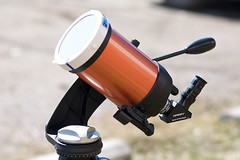Observing sunspots
 I bought a solar filter a year and a half ago, but I had the bad luck to do so at the height of the solar minimum — i.e., I bought a filter specifically for the purpose of viewing sunspots at the point when sunspots were at their most scarce. Not only that, it was the most minimal solar minimum in nearly a century.
I bought a solar filter a year and a half ago, but I had the bad luck to do so at the height of the solar minimum — i.e., I bought a filter specifically for the purpose of viewing sunspots at the point when sunspots were at their most scarce. Not only that, it was the most minimal solar minimum in nearly a century.
So every so often I would attach the filter to the telescope, point the telescope at the sun, and see if there were any spots. The technical term for what I saw was “bupkis.” In all of astronomy, there is nothing less interesting than using a solar filter to view the sun when there are no sunspots — it’s just a featureless ball.
 I had since heard that sunspots and prominences were returning as the solar cycle progressed, but I hadn’t had the opportunity to check it out for myself until yesterday, when I finally saw my first sunspot. Just one, and it wasn’t very big. Naturally, I tried to take a photo, which turned out less well than I had hoped: there was a lot of atmospheric shimmer, and it was hard to get the scope into focus with the camera attached. And I had to guess at the right exposure; I was usually too long, and therefore too bright — at 1/50th of a second, the sunspots were washed out, but I had better results at 1/250 s.
I had since heard that sunspots and prominences were returning as the solar cycle progressed, but I hadn’t had the opportunity to check it out for myself until yesterday, when I finally saw my first sunspot. Just one, and it wasn’t very big. Naturally, I tried to take a photo, which turned out less well than I had hoped: there was a lot of atmospheric shimmer, and it was hard to get the scope into focus with the camera attached. And I had to guess at the right exposure; I was usually too long, and therefore too bright — at 1/50th of a second, the sunspots were washed out, but I had better results at 1/250 s.
But at the very least it gave me a baseline for future attempts. Next time, I’ll try it with the focal reducer, to reduce the size of the sun’s image — it nearly filled the frame, which made it hard to center, and probably bumped up against the scope’s coma and curved field. With the reducer, I’ll have to take even shorter exposures as well.
And who knows? There might be more sunspots next time.